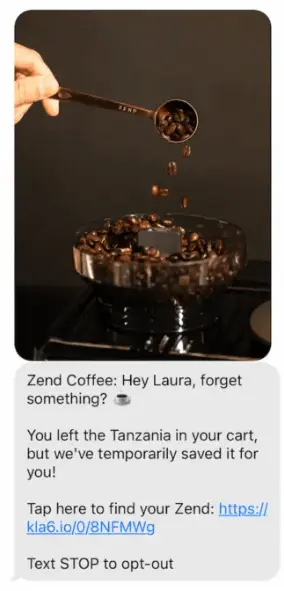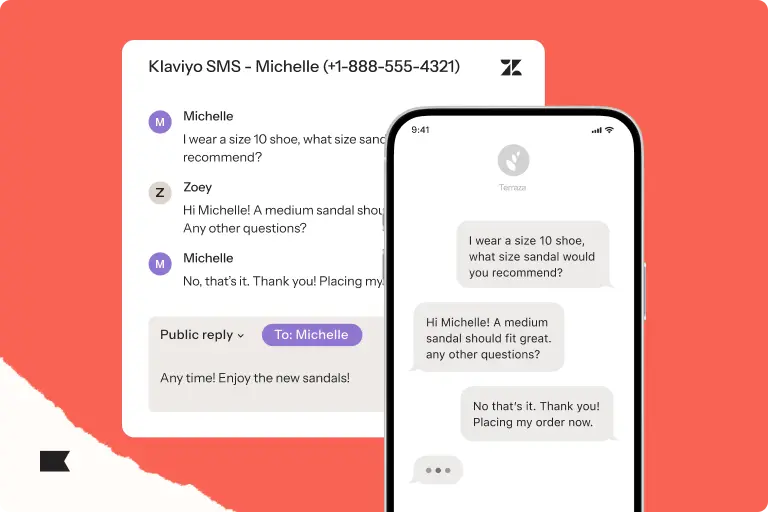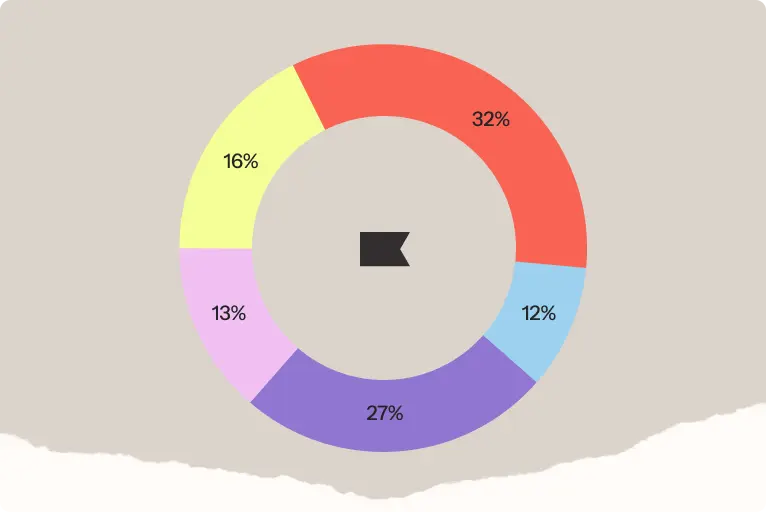SMS marketing strategy: how to build a winning plan in 2025
SMS marketing is no longer risky or radical. When people get texts from brands, it’s because they want to.
A 2024 Klaviyo survey of nearly 9,000 consumers found that when people subscribe to your SMS messages, 72% of them expect to receive text messages at least once a week—and of that majority, 45% expect to receive SMS messages from you more than once a week.
With the right SMS marketing strategy, brands can consistently reward their SMS subscribers for their deep interest, attention, and loyalty. But a lot goes into executing a strategy that works.
That’s why we recommend breaking down your SMS strategy into stages appropriate for your business:
- Crawl: foundations for B2C brands of any size that are just starting out with SMS
- Walk: growth strategies for B2C brands that have an established SMS list
- Run: above-and-beyond SMS marketing strategies for B2C brands that want to move beyond standard flows and campaigns with a more personalized SMS marketing strategy
What is an SMS marketing strategy?
An SMS marketing strategy is a thoughtful and planned approach to sending promotional, conversational, or transactional text messages to subscribers who have opted in. When you design your SMS marketing strategy, you’ll determine the most effective ways to grow your SMS list, the most relevant types of messages to send via text, and an approach to audience segmentation that can facilitate the personalized offers consumers have come to expect.
Your SMS marketing strategy will look different depending on the type of text messages you’re sending. Whereas your transactional SMS strategy is more about good customer service, a promotional SMS strategy is about generating revenue with VIP offers, limited-time discounts, product launches, and hyper-personalized automations triggered by subscriber behavior.
Why is an SMS marketing strategy important?
Your SMS subscribers are some of your most engaged. If someone has given you their phone number, their intent to buy (or buy again) is likely high. Even if your SMS list is on the smaller side, especially at first, the channel is still incredibly valuable for its high engagement and revenue potential.
When you prioritize a thoughtful approach to SMS marketing strategy, you can expect:
Faster time to purchase
According to the aforementioned Klaviyo survey, 65% of people who made an SMS purchase in the last year said it was something they were planning to buy—but because of a promotional text message, they ended up buying the item earlier than they’d planned.
More repeat purchases
In 2024, 86% of people made 2+ purchases in the last year from SMS messages, up from 55% in 2022. And within that group, 30% said they made 4+ purchases from SMS in the last year, while almost 10% made 6+ purchases.
Faster feedback cycles for more targeted personalization
SMS marketing thrives on instant gratification. The channel is at its most effective when it’s used for personalized automations (such as abandoned cart messages), VIP offers, limited-time discounts, and any call to action that requires immediate engagement.
Fact action means fast learning. With real-time SMS analytics, you’ll be able to implement your strategy, test audience segments and messaging, and see results within shorter cycles than other marketing channels. Increased testing volume can lead to better insights, which can lead to more personalized offers for audience segments.
Crawl with SMS marketing strategy: establish a presence
It’s true—you need to crawl before you can walk. This is actually crucial for SMS marketing because you need to comply with federal regulations the moment you start sending text messages.
To make sure you’re covered and know where to start once you are, here’s what to do:
1. Lay the foundation for compliance before sending
One of the most attractive features of SMS marketing is that it requires explicit permission from recipients. This is how you know you’re interacting with a group of highly interested people when you send an SMS campaign.
To reap that reward, you’ll need to establish the groundwork for a consent-based SMS relationship. Here’s how:
Update your existing privacy policy
Add language to your existing policy that describes your SMS program and what you’ll do with the phone numbers you collect.
If you’re planning to use SMS for abandoned cart flows, you must explicitly state how information is captured by your website to determine when a customer’s cart has been abandoned (e.g., website cookies, plug-ins, etc).
Include a link to your privacy policy on your SMS sign-up form.
Get explicit consent to send SMS, not just email
If you have someone’s phone number but they’ve only opted into email, that doesn’t mean you have consent to send them text messages.
On your SMS sign-up form (more on this next), include language that explicitly states you’ll be sending marketing messages to the phone numbers you’re collecting.
Use double opt-in to confirm sign-up
No matter how you’re getting people to sign up for your SMS list, an important best practice is using double opt-in to confirm that you have their explicit consent to receive SMS marketing.
After a subscriber signs up for SMS marketing, they must also confirm their sign-up by replying something like “YES” when they receive the first text from your brand.
Klaviyo features like Smart Opt-in and tap-to-text forms meet double opt-in requirements while making it easier and more convenient for people to subscribe to your SMS marketing.
Provide an easy way to opt out with a STOP keyword
Similar to email, you need to give people the option to unsubscribe from SMS if they want to. We recommend using the keyword STOP, and letting recipients know they can use this keyword to unsubscribe.
While it’s not necessary to include the reminder with every message, we recommend including it for the first and every fifth message. At minimum, include STOP language once a month.
2. Grow your SMS list with a targeted sign-up form
After you’ve set up your compliance foundation, you’re ready to collect phone numbers. Since handing over a phone number usually requires an existing relationship, we recommend starting with a sign-up form that appears only to visitors who are already on your email list.
If you’re feeling bold and you want to challenge that assumption, use a multi-step form. With this type of form, the first screen asks the visitor for their email address. Once they submit that form, they arrive on a second screen which also asks them for their phone number.
If you go this route, consider incentivizing people with a larger discount for an SMS sign-up.
3. Ask for SMS consent at check-out
One of the best ways to ask for a phone number is when a customer checks out. You can easily add this option in Klaviyo if you use Shopify, WooCommerce, Adobe Commerce (Magento), or BigCommerce.
The best part? The customer doesn’t need to complete their order for Klaviyo to capture their consent. That means you can grow your SMS list even if someone abandons the check-out process.
4. Create SMS welcome and abandoned cart automations
First impressions matter. It’s critical to build your SMS welcome flow as soon as visitors opt in, so that every new subscriber receives communication right away.
SMS welcome flow
The role of a good welcome text is to educate new subscribers about your brand and products—and even inspire their first purchase. When crafting yours, consider including:
- The name of your brand
- A thank you for subscribing
- What subscribers can expect from future texts
- An offer with a discount code
- A CTA leading back to your website with a next step
- Opt-out STOP instructions
SMS abandoned cart flow
According to the Baymard Institute, 70% of online shoppers abandon their carts—and SMS is a great way to encourage visitors to finish their purchase.
Even if you’re already using email to prompt those shoppers to take the final plunge, incorporating SMS into your existing flows could help you increase your conversion rates even more. Consider including:
- The name of your brand
- An image of the product they left behind
- The name of the product they left behind
- Personalization elements, such as first name
- A link back to the cart they abandoned
- An offer with a discount code
- Opt-out STOP instructions
This MMS example from coffee brand Zend Wellness exemplifies nearly all these abandoned cart components:

Source: Zend Coffee
5. Start sending 1–4 SMS campaigns per month
After you’ve spent some time collecting SMS subscribers, you’re ready to start sending.
To start, we recommend sending at least 1–4 SMS campaigns per month on a consistent basis. This way, you can learn what works and what doesn’t for your brand, build a consistent relationship with your subscribers, and start generating reliable deliverability and ROI.
Not sure what to send? Klaviyo AI features like SMS AI can help you generate copy. SMS marketing campaign must-haves are:
- Your company name
- A time-sensitive offer
- An element of personalization
- A shortened link—which can be customized for your brand
- A STOP unsubscribe reminder, if it’s your first message or you haven’t included one in the last 5 messages/1 month
You can also enhance your message with an image or GIF under 600 KB. This will convert the message into an MMS, which also allows you more than 1,600 characters. Just remember that MMS messages cost more than SMS messages under most billing plans.
6. Create SMS-specific audience segments
Segmentation is how you stay relevant with your audience and create personalized campaigns. As soon as you make it a habit to blast your entire list with the same messages, you’ve lost.
This is particularly important in SMS, where people are far less likely to tolerate irrelevant messages for long. Klaviyo’s 2025 future of consumer marketing report found that 74% of consumers actually expect personalized brand experiences—which is why audience segmentation is so important.
Here’s where to start with SMS segmentation:
SMS consented
Use this segment to separate your SMS subscribers from your email list. When someone provides your brand with their phone number, it’s an indicator that they’re more than casually interested in your brand.
SMS 30-day engaged
Use this segment to separate people who recently interacted with your texts from those who haven’t. This indicates an intent to buy that’s a tier above simply subscribing to texts. You may want to give these folks special access or discounts on products.
SMS errors
Use this segment to separate subscribers who aren’t receiving messages from ones who are and exclude them from regular sends. In Klaviyo, you can create segments for a variety of SMS error types as part of monitoring the overall health of your SMS program (more on that next).
7. Measure early performance rates
As soon as you send your first SMS campaign, start keeping track of SMS metrics.
In the beginning, especially, make sure your deliverability—the number of text messages that are actually delivered, not just sent—is sitting at 95% or above. This is indicative of the overall health of your SMS program.
According to Klaviyo’s latest SMS marketing benchmarks, you should aim for 5.76% click rates and 0.1% placed order rates on your SMS campaigns. Use Klaviyo’s SMS reporting dashboard to track list growth, revenue, engagement, and deliverability, or dive deeper into deliverability with Klaviyo’s SMS deliverability hub.
Walk with SMS marketing strategy: send more and grow
After you’ve established an SMS list, sent a few campaigns, and set up your basic flows, you’ll likely know enough about what works and what doesn’t to start confidently scaling your SMS efforts.
1. Build trust with branded links
It’s standard to include a shortened link in your SMS campaigns. For brands that use Klaviyo for SMS, links look like this example from Leggari Products, a brand “dedicated to simplifying the epoxy resin industry”:

Source: Klaviyo Showcase
But when brands become more established with SMS, they may want to start using branded links, which include the name of their brand within the link itself.
Branded links build more trust between you and your recipients by showing them you’re not sending spam. This is important given the rise of text and email phishing scams, when people are understandably more wary of links that look suspicious.
2. Grow your SMS list with a targeted email campaign
Your email subscribers already care about your brand, so they’re the most likely people to opt into your SMS program. But you never get what you don’t ask for—so it’s smart to send an email campaign with the goal of collecting phone numbers.
At this stage, consider sending your email subscribers to a sign-up form with Smart Opt-in enabled. Smart Opt-in is an easy way to confirm both consent and a real phone number, which can significantly increase deliverability rates.
When someone signs up with Smart Opt-in, they receive a code (e.g., 284764) that auto-populates a separate form to confirm their phone number. If you’re already using double opt-in to confirm phone numbers, consider this a more user-friendly way to do it.
3. Send more SMS campaigns
Scaling your SMS marketing efforts means increasing your monthly SMS cadence to grow owned revenue. At this stage, we recommend increasing to 5–8 campaigns per month:
- 1 campaign each week to your full list
- 1 targeted campaign each week to your 90-day engaged segment
Ben Zettler, founder of digital marketing and ecommerce agency Zettler Digital, explains that this is about staying top of mind to avoid unsubscribes: “If you build a list and you don’t send a text in 6 months, then there are all these subscribers you’ve accumulated who haven’t heard from you—and they may not even remember that they signed up.”
4. Start sending transactional SMS flows
A natural progression from promotional SMS: transactional SMS.
Transactional SMS messages are post-purchase text messages that keep customers informed about a purchase. They improve the customer experience by:
- Updating people on the status of shipment and delivery
- Allowing customers to modify an order without an account log-in
- Connecting customers to agents who can answer questions about an order
Here are some solid examples of different types of transactional SMS:
Account verification
EGGSHELL: Hi Kelsey! You’re signed up to receive shipment notifications about order #12345. Text HELP to reach customer service, or STOP to opt out of SMS. Msg & data rates may apply.
Order confirmation
EGGSHELL: Hi Ope! Heads up, we’ve received your order #12345. Text HELP to reach customer service, or STOP to opt out of SMS.
Shipping confirmation
EGGSHELL: Hi Amrita! Exciting news—your order #12345 has shipped! Expect delivery within 3 days. Track here: [tracking link] Text STOP to opt out of SMS.
Out for delivery
EGGSHELL: Hi Jen! Today is the day—your order #12345 is out for delivery! Expect delivery before 5pm today. Track here: [tracking link] Text STOP to opt out of SMS.
Delivery confirmation
EGGSHELL: Hi Nadeem! Your order #12345 has been delivered. Text HELP to report a lost package. We hope you love your purchase!
5. Expand SMS engaged and VIP segments
The more subscribers you add to your SMS list, the more SMS segments you need to create. As your SMS subscriber list scales, consider developing campaigns for these segments:
SMS VIPs
For some brands, customers reach VIP status when they buy 5x. For others, it’s 2–3x, or a certain spend threshold. No matter how you set your VIP criteria, this is the segment you want to treat with special offers and early access to new products.
Prefers SMS
Even if you have subscribers who have opted in to both email and SMS, some of them may prefer one communication channel over the other. Create a “prefers SMS” segment using their direct behavior as conditions, such as profiles that interact with your SMS messaging frequently but have not recently interacted with your emails.
SMS 60- and 90-day engaged
When your list is on the smaller side, targeting 30-day engaged recipients with offers is standard. But when your list grows, you can feel free to experiment with 60- to 90-day engaged recipients, so you’re sending to more people who might buy.
6. Execute more complex A/B tests
With scale comes strategy refinement. At this stage, whether you’ve been running small A/B tests or none at all, it’s time to layer on some complexity to your testing strategy so you can make your content more effective.
Must-have A/B tests at this stage are:
SMS vs. MMS
MMS messages are more expensive than SMS, but they can also yield more revenue—you won’t know if MMS messages are worth it for your brand until you test.
Send time
SMS marketing is about immediacy and urgency, so send time matters a lot with this channel. Test which time of day yields the most engagement.
Incentives
Testing is how you discover which incentives work for email, and which ones work for SMS—they may not be the same. It might be as simple as offering 10% off, but subscribers also appreciate being in the inner circle. SMS marketing can provide early access to deals or new products, which are great ways to pique their interest.
Message length
It’s a best practice to keep SMS messages short and sweet, but you won’t know your audience’s tolerance for length unless you test. VIP audiences, for example, may appreciate more depth and explanation, and be more likely to engage because of it. Experiment.
Run with SMS marketing strategy: expand and optimize
This stage is ideal for B2C brands that want to move beyond standard flows and campaigns with a more personalized SMS marketing strategy.
At this point you have solid data and insights about the performance of your SMS marketing program, and you’re ready to maximize growth of the channel. Here’s how:
1. Expand to multi-channel list growth
At this stage, it’s time to expand your SMS list growth beyond sign-up forms. Multi-channel SMS list growth involves leveraging channels outside your website, and it’s ideal for businesses who operate brick-and-mortar stores and invest in great packaging.
Execute multi-channel list growth by:
Adding QR codes to in-store signage, physical receipts, and packaging
- Similar to discounts on website pop-ups, incentivize people to scan an in-store QR code that leads to an SMS sign-up page. Bonus points if they can use the discount instantly for an in-store purchase.
- Train your sales associates to circle the QR code on the receipt and mention a discount upon sign-up.
- Ask for a sign-up on your packaging with a discount to incentivize a next purchase.
Adding a mobile two-tap link to social channels
Ideal for Instagram Stories, add a link to a single-field form so people can submit their phone number in just two taps.
2. Maximize your flow types
As your SMS marketing program expands, so does the work to run it—the campaign planning, the content creation, the performance monitoring, etc.
This is when it becomes important to make the most out of automation, which allows you to set up send criteria and content once without adding more resources.
Here’s a list of automations to consider:
Conversational SMS
With conversational SMS, you can use a combination of AI and human agents to answer customer questions during the pre- and post-purchase phases.
Back-in-stock notifications
Back-in-stock notifications are text notifications that are triggered when a product is back in stock. They go out to targeted segments that have shown interest in an out-of-stock product that’s now ready to ship.
Price drop alerts
The price drop alert is perfect for SMS, as it requires subscribers to act fast and take immediate action. Make this flow mobile-exclusive by using filters to send only to SMS subscribers.
Replenishment reminders
Ideal for subscription businesses, this flow uses a time-based trigger to remind customers when it’s time to re-up on a product.
Low inventory alerts
For segments that have shown interest in a particular product, either via product page visits, abandoned carts, or purchases, send an urgency message as soon as your online store indicates you’re running low on a product.
3. Segment by location and loyalty
Whether you operate brick-and-mortar stores in multiple cities or sell only online, it’s time to start segmenting:
By location
To build a connection with your audience in real life, send them event notifications, in-store discounts, location-based flash sales, etc. One of the primary benefits of location-based targeting with brick-and-mortar is that customers may spend more once they’re in the store.
With your loyalty program
SMS marketing and loyalty programs belong together like peanut butter and jelly. Segment your loyal customers by points earned, customer lifetime value, average order value, etc., and create immediacy based on how they’ve interacted with your loyalty program before.
Use Klaviyo B2C CRM to connect with your most active audience
Your SMS marketing strategy is only as good as the data it’s drawing from. Klaviyo B2C CRM, the only CRM designed for B2C brands, makes it easy to personalize your promotional text messages by consolidating your customer data, marketing automation, customer service, and analytics in a single platform. This is how B2C brands can deliver the personalized experiences consumers have come to expect, at scale.
Use Klaviyo SMS marketing to:
- Feel secure knowing you’ve checked all the SMS compliance boxes.
- Grow your list with targeted sign-up forms, QR codes, consent at check-out, and AI-powered forms display optimization.
- Integrate SMS marketing into your owned marketing strategy with email.
- Send personalized messages with hyper-specific audience targeting.
- Engage with your customers with conversational and transactional SMS.
- Speed up content creation with AI-generated copy and replies.



